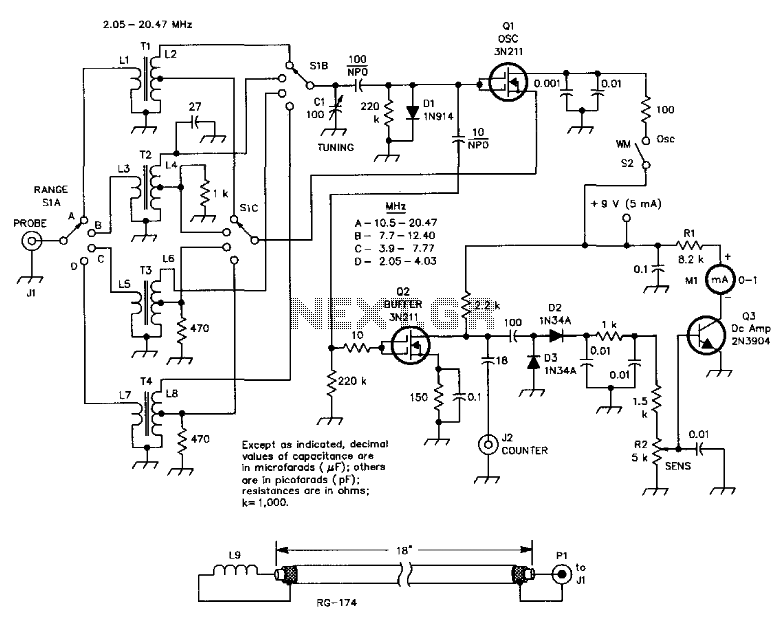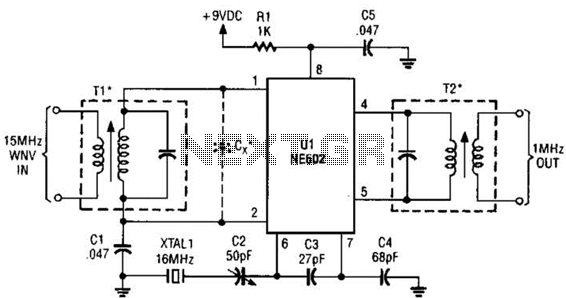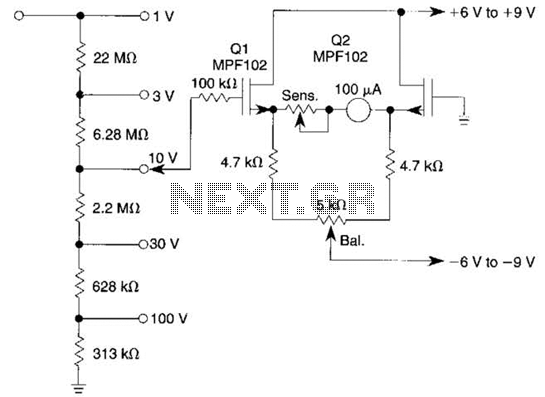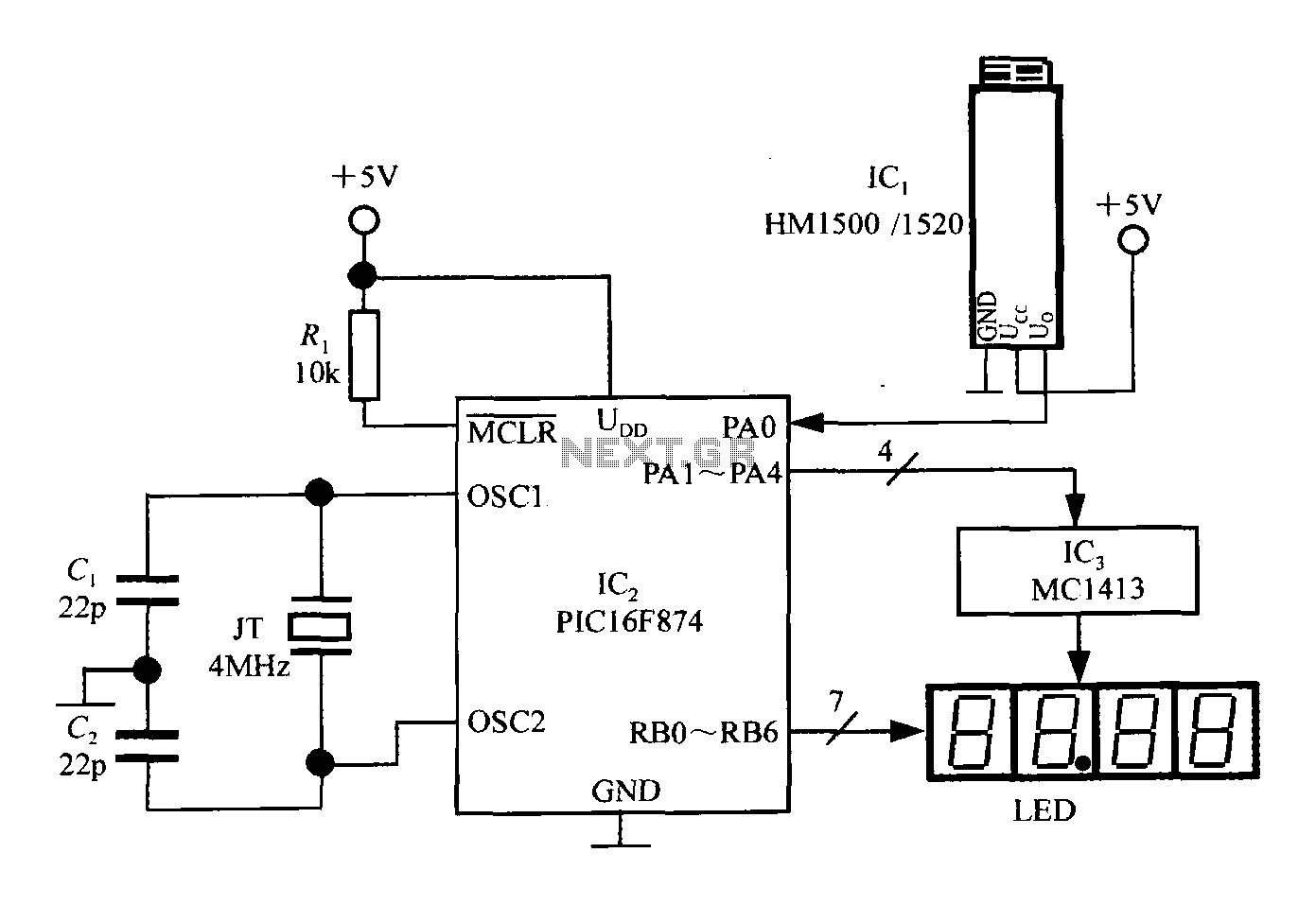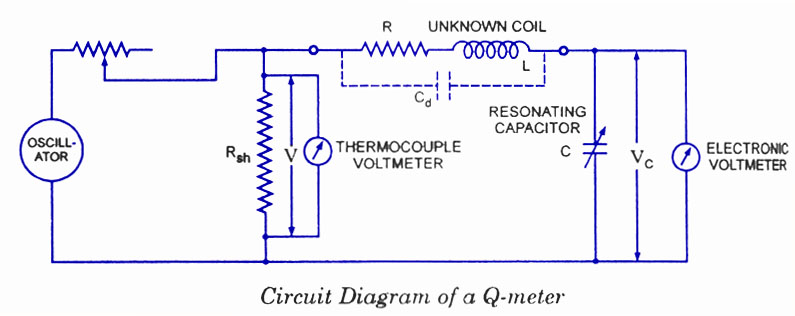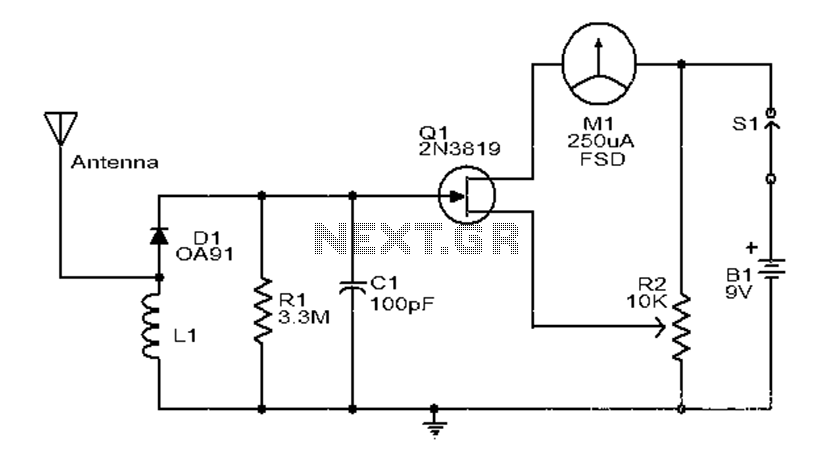
simple swr and pwr meter
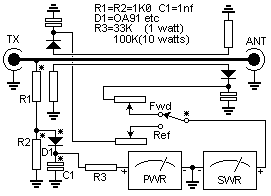
Many SWR (Standing Wave Ratio) and power meters used by amateur radio operators provide reasonably accurate continuous average power readings with a CW (Continuous Wave) key-down signal. However, these meters may not reliably measure Peak Envelope Power (PEP) or average power with modulated signals. This document aims to explain the complexities involved in power measurement and the importance of understanding the characteristics of the instrument. A reflectometer-type SWR meter can be calibrated to provide power readings in both forward (PF) and reflected (Pr) directions on a power supply. A classic example is the 1943 Bird Series power meter, which utilizes a directional coupler to obtain a sample voltage proportional to the forward or reflected voltage on the feeder (VF, VR). Other systems, potentially more suitable for HF (High Frequency), employ bridge circuits to achieve similar results. The sampled voltage is rectified and displayed on a meter calibrated in watts. Typically, if the counter uses a coil, the scale represents power values proportional to the square of the applied voltage or current calibration. The underlying theory is straightforward and is represented by the equation PF = Vf²/Zo. It is important to note that if the load impedance differs from the calibration value, measurement errors will occur. The output voltage of the rectifier reflects either VF or VR, which is integral to the meter's calibration. Examples of directional couplers and bridge-type reflectometers are illustrated in Figures 1 and 2, while the Bird directional coupler model 43 is depicted in Figure 3. It should be noted that in all cases, the measurement circuit incorporates a small RC time constant, which makes the system unsuitable for PEP measurements, and the lack of a specific quadratic device renders them inadequate for measuring average power.
In the realm of RF (Radio Frequency) engineering, SWR and power meters are essential tools for assessing the efficiency of antenna systems and ensuring optimal performance. The operation of these meters is based on the principles of transmission line theory, where the relationship between forward and reflected power is critical. The directional coupler in instruments like the Bird Series meter functions by splitting the input signal and directing it through two paths, allowing for the measurement of both forward and reflected power without interference.
The calibration of these meters is crucial, as it directly affects measurement accuracy. The meters are designed to work with specific impedance values, typically 50 ohms, which is standard in many RF applications. When the load impedance deviates from this value, the reflected power readings may not accurately reflect the actual performance of the system. Therefore, users must ensure that their measurement environment matches the calibration settings of the meter.
Bridge circuits used in some SWR meters serve a similar purpose, allowing for more versatile applications, especially in HF bands. These circuits utilize the principle of impedance matching to provide accurate power measurements across varying frequencies and load conditions. The rectification process converts the AC voltage to a DC signal, which is then displayed on the meter. This conversion is essential for providing a stable reading that corresponds to the power levels being measured.
Furthermore, the small RC time constant in the measurement circuits is a design consideration that limits the response time of the meter. This characteristic, while beneficial for measuring steady-state power levels, poses challenges for capturing transient signals, such as those found in modulated transmissions. As a result, these meters are better suited for continuous wave signals rather than dynamic or pulsed signals.
In conclusion, while SWR and power meters like the Bird Series provide valuable insights into RF performance, users must be aware of their limitations, particularly regarding PEP and average power measurements. Understanding the fundamental principles behind these instruments, including calibration, impedance matching, and rectification processes, is crucial for accurate power measurement in amateur radio applications.Many SWR / Power meter used by amateurs to the extent reasonably accurate continuous average power with a CW key-down signal, but can not reliably be used with other (modulated) signals PEP or average power measurement. These laws seek to show why the power measurement can be a sensitive issue, and because the interpretation of a yardstick of power
can be a lot of attention and knowledge of construction and the characteristics of the instrument. A reflectometer-type SWR meter can be calibrated to give power back and forth (PF, Pr) on a power supply. A classic example is the 1943 Bird Series power meter, which is a directional coupler is used to obtain a sample voltage proportional to the voltage wave or forward or backward on the feeder (VF, VR).
Other systems, perhaps more suitable for HF, then use a bridge circuit to perform the same function. The sample voltage is then rectified and displayed on a meter that is calibrated in watts. If the counter is typically a coil, the scale, so the numbers on the scale, representing the power, are proportional to the square of the applied voltage or the current calibration. The theory of this type is very simple and is based on the concept represented by PF = Vf2/Zo. Note that if the power supply has an impedance that differs from the value of how the instrument is calibrated, there will be a mistake.
The output voltage of the rectifier is a solid phase of VF or VR, and this is expected in the calibration of the meter. Examples of directional coupling, and bridge-type reflectometers are shown in Figures 1 and 2, while the bird directional coupler means 43 is illustrated in Figure 3.
Note that in all cases the measurement circuit, a combination with a small RC time constant, making the system unsuitable for the measurement of PEP, and the absence of a specific device quadratic, making them unsuitable for measuring the average power. 🔗 External reference
In the realm of RF (Radio Frequency) engineering, SWR and power meters are essential tools for assessing the efficiency of antenna systems and ensuring optimal performance. The operation of these meters is based on the principles of transmission line theory, where the relationship between forward and reflected power is critical. The directional coupler in instruments like the Bird Series meter functions by splitting the input signal and directing it through two paths, allowing for the measurement of both forward and reflected power without interference.
The calibration of these meters is crucial, as it directly affects measurement accuracy. The meters are designed to work with specific impedance values, typically 50 ohms, which is standard in many RF applications. When the load impedance deviates from this value, the reflected power readings may not accurately reflect the actual performance of the system. Therefore, users must ensure that their measurement environment matches the calibration settings of the meter.
Bridge circuits used in some SWR meters serve a similar purpose, allowing for more versatile applications, especially in HF bands. These circuits utilize the principle of impedance matching to provide accurate power measurements across varying frequencies and load conditions. The rectification process converts the AC voltage to a DC signal, which is then displayed on the meter. This conversion is essential for providing a stable reading that corresponds to the power levels being measured.
Furthermore, the small RC time constant in the measurement circuits is a design consideration that limits the response time of the meter. This characteristic, while beneficial for measuring steady-state power levels, poses challenges for capturing transient signals, such as those found in modulated transmissions. As a result, these meters are better suited for continuous wave signals rather than dynamic or pulsed signals.
In conclusion, while SWR and power meters like the Bird Series provide valuable insights into RF performance, users must be aware of their limitations, particularly regarding PEP and average power measurements. Understanding the fundamental principles behind these instruments, including calibration, impedance matching, and rectification processes, is crucial for accurate power measurement in amateur radio applications.Many SWR / Power meter used by amateurs to the extent reasonably accurate continuous average power with a CW key-down signal, but can not reliably be used with other (modulated) signals PEP or average power measurement. These laws seek to show why the power measurement can be a sensitive issue, and because the interpretation of a yardstick of power
can be a lot of attention and knowledge of construction and the characteristics of the instrument. A reflectometer-type SWR meter can be calibrated to give power back and forth (PF, Pr) on a power supply. A classic example is the 1943 Bird Series power meter, which is a directional coupler is used to obtain a sample voltage proportional to the voltage wave or forward or backward on the feeder (VF, VR).
Other systems, perhaps more suitable for HF, then use a bridge circuit to perform the same function. The sample voltage is then rectified and displayed on a meter that is calibrated in watts. If the counter is typically a coil, the scale, so the numbers on the scale, representing the power, are proportional to the square of the applied voltage or the current calibration. The theory of this type is very simple and is based on the concept represented by PF = Vf2/Zo. Note that if the power supply has an impedance that differs from the value of how the instrument is calibrated, there will be a mistake.
The output voltage of the rectifier is a solid phase of VF or VR, and this is expected in the calibration of the meter. Examples of directional coupling, and bridge-type reflectometers are shown in Figures 1 and 2, while the bird directional coupler means 43 is illustrated in Figure 3.
Note that in all cases the measurement circuit, a combination with a small RC time constant, making the system unsuitable for the measurement of PEP, and the absence of a specific device quadratic, making them unsuitable for measuring the average power. 🔗 External reference
